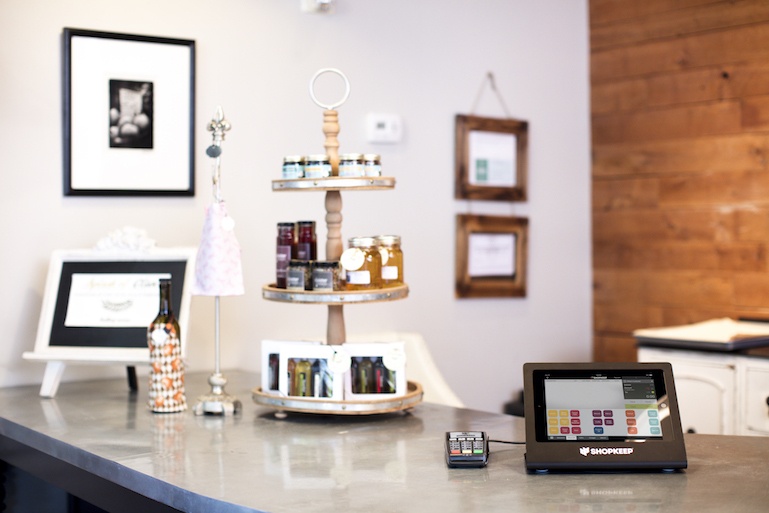
How to Manage Inventory in a Retail Store
Owning a business is all about being productive and profitable, but let’s be honest, mismanaging your inventory isn’t going to get you there.
The main goal of any retail business is selling inventory, but you can’t sell anything if you don’t know where it is, where it’s supposed to go, and how much you have. Peace of mind and a more efficient business are waiting for those who tackle their inventory head-on. Keep reading for a better understanding of what retail inventory management is and how you can use it to transform your retail store.
What is Retail Inventory Management?
Retail inventory management is what keeps your whole business in order. (Well, that and your POS system.) It is the set of systems and tools you use to keep track of the inventory in your store. This may seem like a simple task, but there’s a lot of information that goes into managing your inventory:
- How much of each item is in stock?
- What and when do you need to reorder?
- Are you ordering too much or too little inventory?
- What are your best and worst selling items?
- Should you stop selling something completely?
- Is your inventory storage sufficient?
Inventory management is either taken by hand or electronically. While some may prefer to take inventory by hand, this can be a long and tedious process, especially for stores with larger inventories or a lot of really small items in their inventory. You also have to update your numbers daily to keep track of sales and stock levels. All of this equals far more math than you may have asked for, as well as much more work. Most business owners don’t have that kind of energy and time.
Managing retail inventory electronically, ideally through a POS system, makes everything easier on you. There’s no need to crunch numbers or spend hours at your desk when your POS updates all of that for you automatically. All you need to do is log in to your POS and you can check your inventory levels almost instantly. You can see what sales were made, when, and by who, as well as what your best selling items are, and even who made the sales. This method takes minutes, not a full afternoon.
With proper inventory management strategies in place, you’re always in control and always know what’s going on in your business. Without the right system in place, you’re asking for trouble.
What Does A Business Without Inventory Management Look Like?
To be honest, it’s a mess. If an inventory management system keeps everything in order, your business will clearly be out of order without one. At the end of the day, this affects your business’ bottom-line, making it hard continue operating, let alone grow.
A lack of a good inventory management process means you don’t know where anything is so you can’t sell it. Mismanaged items are more easily stolen. So, not only are you spending money on unknowingly replacing stolen goods, but you’re also spending on storage space you aren’t using, paying staff who may be stealing from you, and wasting money on things that aren’t selling.
You can also run out of stock more easily. If you have a popular jacket, for example, mismanaging that stock could mean that you ordered too few of them, couldn’t keep up with demand, and you never realized it until it was too late. Now, your stock is sold out and your customers will have to shop somewhere else.
It can be scary to think about having to implement an inventory management solution into your store’s operations. Furthermore, you’ll then need to add all of your items into that system, which might seem like a tremendous amount of work for a busy business owner. The good news is that it doesn’t have to be all headaches and spreadsheets. There are different methods for inventory management that you can check out to find your perfect fit.
Before we go over those, let’s look a little bit more closely at the benefits you’ll see from staying on top of inventory management in your retail store.
SEE ALSO: 3 Tips to Make Inventory Management Less Painful
Why You Need a Retail Inventory Management Solution
Imagine the mess you would have if you didn’t manage your inventory. What inventory do you have to sell? How much did it cost you? Where is it? If done correctly, inventory management will keep many other aspects of your business in line. It gives you the clarity to notice so many issues before they have the chance to spiral out of control. It will help you solve challenges like the following:
- Spending Too Much on Inventory and Storage Space: Managing the money you spend on your inventory and storage space of course saves you money. Many times the cost of storage is dependent on the amount of inventory you need to store. To optimize your inventory storage, use a planogram. A planogram is the blueprint of your store’s layout. This tool makes sure you use your space with a profitable mindset. A planogram can help you arrange your merchandise in a way that catches the customer’s eye, organize the space in a way that gives you more room on your shelves, and help you always know how much to place on the sales floor.
- Loss Prevention (Retail Shrinkage): Stealing accounts for the biggest form of loss for retail stores. $50 billion was lost from the retail industry in 2016 as a result of theft. Unorganized space makes it easier for customers, and even staff, to steal right from under your nose without you even noticing. Even if it doesn’t come naturally to you, keeping your inventory organized is one of the first things you can do to prevent loss and retail shrinking. Plus, organizing your space helps you know where everything is. You can’t manage stock if you can’t find it.
- Administrative Errors: Administrative errors, like miscounting stock, are a major cause of lost inventory and theft in retail stores. More than 20% of the loss in a business is caused by administrative and paperwork errors. This is why taking inventory by hand isn’t the best method. Your POS system eliminates the errors a staff member can make.
- Avoiding Dead Stock: When running a retail business you know how quickly things can go in and out of fashion. Dead stock is excess inventory that isn’t selling or has been difficult to sell for long periods. Sometimes trends and fads go by quickly and it can be difficult to keep up without your inventory taking a hit. You can use a planogram to determine the best place to put a sales rack, for example, and keep best-selling items at the front of your store.
- Avoiding Being Out of Stock: The complete opposite can also be true of a retail store when inventory is mismanaged. If something is selling really well you need to make sure it’s always on hand, or risk losing sales.
- Managing Your Supply Chain: Your supply chain is the process of making and receiving inventory for your store. Many different things affect a supply chain. For example, if you sell gold jewelry and the price of gold just skyrocketed, that means you’re paying more to obtain that jewelry for your retail store. This will have a huge effect on how much you spend on your inventory. Some vendors may also raise prices for their own personal gain. Counteract this by making sure you only do business with reliable vendors and stay on top of changes in your industry.
Think about it, if you know how much inventory you should have at all times, you know how much you spent to get it, how much space and storage units you need to keep it organized, and where it needs to be at all times.
SEE ALSO: Insider Secret: How to Control Inventory in a Small Business
What are Different Inventory Management Methods
Inventory management methods can be as varied and as unique as your business. Some methods may work better for different retail businesses; it is not a “one size fits all” senario.
To help you get started, below you’ll find an overview of the most popular inventory management techniques. Picking the ones that best apply to your business and its needs will help you build an inventory management system that will keep you organized for years to come.
- Physical Inventory Audit: This is probably the most boring and tedious method when it comes to managing inventory, but it can be extremely helpful when managing and making improvements to your budget. You don’t have to count your inventory every single day; your POS should be doing that, but physically counting inventory a couple of times a year helps keep everything in order.
- Spot Checking: If you’re going to do physical inventory audits it’s also a good idea to spot check every so often. That basically means you pick a few items in your inventory to count and make sure the numbers you have now match up to the numbers you’re supposed to have. If these numbers are off by a small margin, you may have just miscounted and it’s back to counting. However, if there’s a large gap between the two numbers you’ll need to figure out why that is.
- FIFO and LIFO: These methods account for when items are added into your inventory. FIFO or first in, first out means that the oldest items in your inventory are the first to be sold. LIFO or last in, first out means that the newest items in your inventory are the first to be sold. You may use these methods interchangeably depending on different items in your inventory. For example, trendy items may have to be ordered quickly and unexpectedly, making them the last items to be added to your inventory, but they will be the first to leave it since the demand is high. Evergreen items like jeans may be put in your inventory first but they all may not sell right away.
- Plan Ahead: Some items in your inventory may need extra special attention. For example, those clothes in your inventory that follow the latest trends will probably sell faster than something from last season. Pay attention to the market you’re a part of and plan your inventory needs around that.
- Retail Management Software: If you’re using a modern POS system, it has the inventory tools that help you manage your inventory and other aspects of your retail business.

It certainly makes sense that your POS helps with your inventory management since the sales processed through your POS directly affect inventory levels and performance. Use your POS to your advantage by leveraging that inventory information to make more informed business decisions.
Get Inventory Help From Your POS
Your POS can be one of your best assets when it comes to managing inventory and pretty much every other part of business. Modern POS software comes with real-time inventory management capabilities that use sales data to consistently keep inventory numbers and key metrics updated. Once a sale is completed, the inventory and sales data sync to give you accurate information about what each sale means for your bottom line and overall business operations.
That sales data is also an important part of ordering inventory. You need to know how well something is selling to determine the quantity you should reorder. If something is selling really well or it’s an item you need regularly, set up a reorder trigger so that when the stock level of your most popular product drops below a certain amount, your POS sends the signal to order more.
Remember those administrative errors we were talking about? Those are basically non-existent when taking inventory with a POS. And since everything automatically updates, you never have to take hours out of your day to take inventory by hand. You can use sales data and analytics collected from each sale to see what your best selling items are. That helps you avoid dead stock and makes you aware of other things that aren’t selling as well to make better inventory choices moving forward.
Plus, you can continue to manage your inventory with your cloud-based POS system on the go. A mobile POS (mPOS) can be run on an iPad to make sales, see sales reports, and, yes, manage your inventory from anywhere in the store. ShopKeep users have the advantage of the Pocket smartphone app that lets business owners see reports from their stores wherever they are.
Running a business is hard enough and not having a good retail management and inventory management system to help out will do more to hurt you in the end. Not only do customers not like an unorganized store, but operations overall run smoothly when everything is in its place. Use these tools to make your business that much more self-sufficient.
Want to try ShopKeep for yourself?
Just answer a few easy questions.
Need help finding the right point of sale?
Just complete the form. We’ll call you right back to explain how ShopKeep can work for you.
Hit the ground running.Sprinting, in fact!
Read our free, comprehensive guide, Small Business 101, to learn all you need to know about starting a thriving business.

